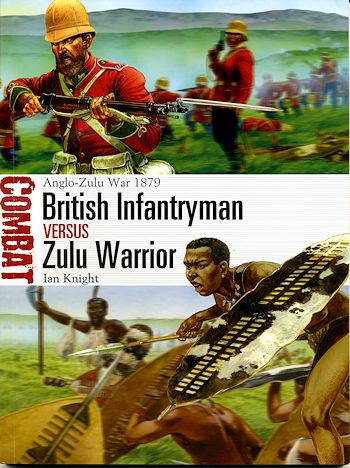Osprey's British Infantryman vs Zulu Warrior
|
Author: |
Ian Knight |
|
Publisher |
Osprey |
|
Price |
$18.95 MSRP |
|
Reviewer: |
Scott Van Aken
|
|
Notes: |
80 pages, 7¼ x 9¼
inches, softbound
ISBN: 978-1-78200-365-6 |
 A sad fact
of the 19th century and before is that those world powers who were both
industrially and militarily strong felt that places that were neither were
theirs for the taking. One of the more egregious players in this empire building
game at this time were the British. They felt it was the will of God or
something for them to 'bring the savages under the caring arms of Britannia' or
some such drivel. One of the reasons they got away with this was due to their
army and their technological superiority in terms of weapons. No place was this
more apparent than in the Anglo-Zulu War of 1879.
A sad fact
of the 19th century and before is that those world powers who were both
industrially and militarily strong felt that places that were neither were
theirs for the taking. One of the more egregious players in this empire building
game at this time were the British. They felt it was the will of God or
something for them to 'bring the savages under the caring arms of Britannia' or
some such drivel. One of the reasons they got away with this was due to their
army and their technological superiority in terms of weapons. No place was this
more apparent than in the Anglo-Zulu War of 1879.
In this book from Osprey in their Combat series,
we take a look at the two main adversaries in this war. One was the British
soldier. He had been trained to some great extent in the ways of battle with
their officers using manuals that provided the latest and greatest in the ways
of war. These were tried and true ways of conducting battle gained through much
experience against other powers and in other places in the Empire.
On the other side of things were the Zulu
warriors. The Zulus had only been united for less than 100 years, but they had a
strong warrior upbringing. Like the British, the Zulu had their troops gathered
into fighting groups. Only unmarried men were eligible to be troops and their
skills at hunting and fighting each other had been honed over the years. They
had a spirit that was unlike that of the British. They knew the territory and
knew how to fight in it.
However, the Zulu had little in the way of modern
weapons. There were rifles and muskets available with some tribesmen using
flintlocks. Hardly standardized stuff. No heavier weapons and the main weapon
was the spear. WHen it came to close-in fighting, the Zulu could not be
defeated. The British had the latest Martini-Henry rifles along with cannon and
Gatling guns. The British also required a rather comprehensive supply train,
something the Zulus did not. The latter item was something that made it
difficult for the British to move in any sort of stealth. The Zulu, on the other
hand, was able to get supplies from locals and often went days without food if
required.
In this book the author takes into consideration
a few early events following the British invasion of Zulu terriorty. It shows
that, in most cases, the advanced weaponry of the British was enough to hold off
the Zulu. However, there were instances when the British did not use this
weaponry to advantage and the result was not good for the redcoats. However, the
British did learn and went to adopting tactics that made sure the Zulu did not
get through as once they did, it was not good for the Brits.
As with other books in this series, we look at
each side in terms of leadership, training, tactics and equipment. This is
followed by several battle examples to see how each side fares and how much they
learn from the experience. The book is superbly illustrated with period photos
and illustrations as well as art work and maps. It makes for a real insight into
the two groups and is a fascinating read in its own right. I'm sure you will
enjoy this one.
December 2013
For more on the complete line of Osprey books,
visit www.ospreypublishing.com. In the US, it is
Osprey Direct at 443 Park Avenue South, New York, NY 10016, where you can
get a catalogue of available books.
If you would like your product reviewed fairly and fairly quickly, please contact
the editor or see other details in the Note to
Contributors.
 A sad fact
of the 19th century and before is that those world powers who were both
industrially and militarily strong felt that places that were neither were
theirs for the taking. One of the more egregious players in this empire building
game at this time were the British. They felt it was the will of God or
something for them to 'bring the savages under the caring arms of Britannia' or
some such drivel. One of the reasons they got away with this was due to their
army and their technological superiority in terms of weapons. No place was this
more apparent than in the Anglo-Zulu War of 1879.
A sad fact
of the 19th century and before is that those world powers who were both
industrially and militarily strong felt that places that were neither were
theirs for the taking. One of the more egregious players in this empire building
game at this time were the British. They felt it was the will of God or
something for them to 'bring the savages under the caring arms of Britannia' or
some such drivel. One of the reasons they got away with this was due to their
army and their technological superiority in terms of weapons. No place was this
more apparent than in the Anglo-Zulu War of 1879.